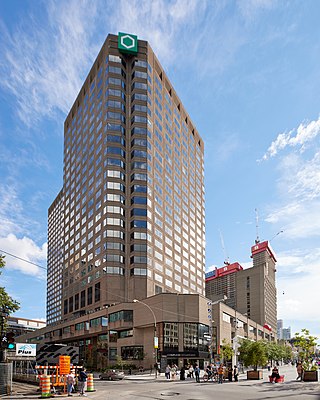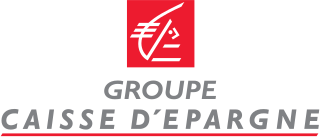
A credit union is a member-owned nonprofit cooperative financial institution. They may offer financial services equivalent to those of commercial banks, such as share accounts, share draft accounts, credit cards, credit, share term certificates, and online banking. Normally, only a member of a credit union may deposit or borrow money. In several African countries, credit unions are commonly referred to as SACCOs.

The Desjardins Group is a Canadian financial service cooperative and the largest federation of credit unions in North America. It was founded in 1900 in Lévis, Quebec by Alphonse Desjardins. While its legal headquarters remains in Lévis, most of the executive management, including the CEO, is based in Montreal.
Little Canada is a name for any of the various communities where French Canadians congregated upon emigrating to the United States, in particular New England, in the 19th and early 20th centuries. A variant of Canadian French known as New England French is still spoken in parts of New England.

A savings bank is a financial institution that is not run on a profit-maximizing basis, and whose original or primary purpose is collecting deposits on savings accounts that are invested on a low-risk basis and receive interest. Savings banks have mostly existed as a separate category in Europe.

Gabriel-Alphonse Desjardins, born in Levis, Canada East was the co-founder of the Caisses Populaires Desjardins, a forerunner of North American credit unions and community banks. For his contribution to the advancement of agriculture in the province of Quebec, he was posthumously inducted to the Agricultural Hall of Fame of Quebec in 1994.

Caisse populaire acadienne ltée, operating as UNI Financial Cooperation, is a Francophone credit union based in New Brunswick, Canada whose members are primarily Acadians. UNI's administrative headquarters are in Caraquet on the Acadian Peninsula.

Cooperative banking is retail and commercial banking organized on a cooperative basis. Cooperative banking institutions take deposits and lend money in most parts of the world.

Banque Populaire was a French group of cooperative banks, with origins in the European cooperative movement. In 2009, it merged with Groupe Caisse d'Épargne to form Groupe BPCE.
Servus Credit Union is a member-owned, community-based financial institution based in Edmonton, Alberta, and in 2015 became the second-largest credit union in Canada and the largest credit union in Alberta. Servus has around 380,000 members, who are served by nearly 2,400 employees from 100 locations in 59 communities across Alberta and as of 2021 has $17.2 billion in assets under its administration.

Groupe Caisse d'épargne was a group of French savings banks that were converted into cooperative banks by legislation enacted in 1999. Its roots went back to the founding in 1818 of the Caisse d'Épargne et de Prévoyance de Paris, initiated by Benjamin Delessert and the Duke of La Rochefoucauld-Liancourt.

Credit unions are not-for-profit financial cooperatives. In the early stages of development of a nation's financial system, unserved and underserved populations had to rely on risky and expensive informal financial services from sources like money lenders, ROSCAs and saving at home. Credit unions proved they could meet demand for financial services that banks could not: from professional, middle class and poorer people. Those that served poorer urban and rural communities became an important source of microfinance.

America's Credit Union Museum is located in Manchester, New Hampshire, on the site of the first credit union founded in the United States. The museum is housed at the original location for St. Mary's Cooperative Credit Association, renamed in 1925 to La Caisse Populaire Ste.-Marie, or "Bank of the People", St. Mary's. In 1996, the building was listed on the National Register of Historic Places as the Building at 418–420 Notre Dame Ave.

Pierre Hevey was a Canadian-born American priest, and second pastor of Ste. Marie Church in Manchester, New Hampshire, in the early 20th century. He played a key role in the establishment of the first credit union in the United States on November 24, 1908, to help his parishioners save money and access credit at a reasonable cost.
Attorney Joseph Boivin was a co-founder and first president of the first credit union established in the United States, Ste. Marie's Cooperative Credit Association.

Credit unions in the United States served 100 million members, comprising 43.7% of the economically active population, in 2014. U.S. credit unions are not-for-profit, cooperative, tax-exempt organizations. The clients of the credit unions become partners of the financial institution and their presence focuses in certain neighborhoods because they center their services in one specific community. As of March 2020, the largest American credit union was Navy Federal Credit Union, serving U.S. Department of Defense employees, contractors, and families of servicepeople, with over $125 billion in assets and over 9.1 million members. Total credit union assets in the U.S. reached $1 trillion as of March 2012. Approximately 236,000 people were directly employed by credit unions per data derived from the 2012 National Credit Union Administration (NCUA) Credit Union Directory. As of 2019, there were 5,236 federally insured credit unions with 120.4 million members, and deposits of $1.22 trillion.

Groupe BPCE is a major French banking group formed by the 2009 merger of two major retail banking groups, Groupe Caisse d'Épargne and Groupe Banque Populaire. As of 2021, it was France's fourth largest bank, the seventh largest in Europe, and the nineteenth in the world by total assets. It has more than 8,200 branches nationwide under their respective brand names serving nearly 150 million customers. Its wholesale banking subsidiary Natixis, previously a separately listed company, was delisted and came under full ownership of Groupe BPCE in 2021.

Canada has significant per-capita membership in credit unions, representing more than a third of the working-age population. Credit union membership is largest in Quebec, where they are known as caisses populaires, and in western Canada.
The presence of the French language and the New England variety of French, in New Hampshire, has been around since the foundation of the state. Workers in the area even developed their own dialect of French.










